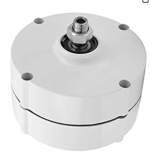I read this as meaning you don't need any mechanical connection between your pedals and drivetrain. If that's not the case, perhaps you could clarify so we can reason about what you want.
If this is what you mean, you are effectively 'ghost pedaling' except that in your case it's physically true that there is no mechanical connection between the pedals and the driven wheel. I can do what you want now by using my stock Grin Baserunner, Cycle Analyst, and hub motor by taking the chain off. The PAS on the cranks signals what I'm doing, the Cycle Analyst and Baserunner tell the motor what to do based on that signal.
Some of the time, I'm doing this now with the chain on - I can pedal and hear the freehub ratchet clicking as the wheel turns faster than the input from the cranks - the signal tells the controller to spin the motor faster than I am pedaling.
I have also set the Cycle Analyst with 20 levels of pedal assist, and I use an up-down rocker (stock equipment) to move up and down through the levels, so that it's like selecting a 'gear' for the motor - the same pedaling will offer different levels of assist and speed/climbing for each. Roughly, think of an electronic push-button gear shift. There are other modes to interpret the signal-to-motor-output which I haven't explored yet.
I do not have, but Grin also sells an 'infinitely' variable dial controller that does the same, but not in jumps. You can set the amount of motor output on the fly to match whatever pedaling speed you cared to use.
This is off the shelf - just don't connect your pedals with a chain to your drive. Does this meet your needs?



